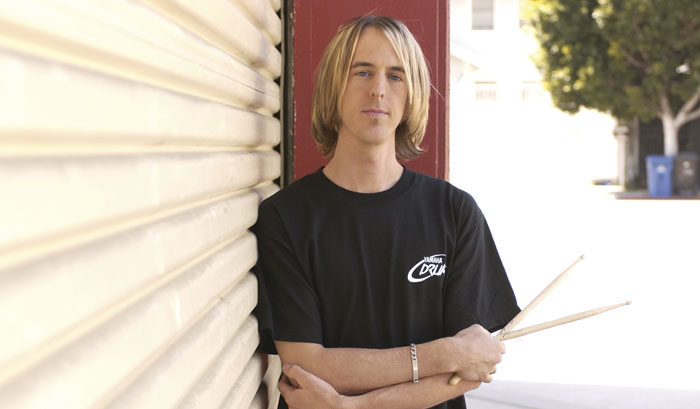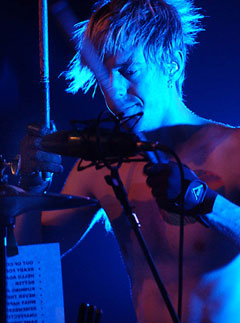


Sometimes you get it right the first time. Take the case of Hoobastank, a young California rock quartet who scored a major success with their self-titled 2001 debut. Their sound melded the dark aggression of such predecessors as Tool and Alice in Chains with a unique brand of radio-ready tunefulness. The result: The radio/video hits "Crawling in the Dark" and "Running Away."
Now Hoobastank has made good on the promise of their debut with The Reason, a disc that finds the group fleshing out its fundamental sound with lusher textures and even more assured playing from the rhythm section of bassist Markku Lappalainen and drummer Chris Hesse.
I used to hand a picture of a Maple Custom Kit on my wall as inspiration.
Ironically, Hesse claims that the new album, which was tracked with producer Howard Benson [Cold, P.O.D.], was actually the easier record to make: "It went much quicker than our debut. Jim Wirt, our original producer [L.A. Guns, Something Corporate], is from the old school of rock producing. Everything was done to tape and punched in until perfect. I spent two weeks doing the drums, almost an entire day on each song, until everything was absolutely perfect. It was labor intensive! But on the second record, it was a little different. Howard also records everything to tape, but he doesn't do much punching in. We would do three or four takes that had the right energy, dump the tracks into Pro Tools, and then edit the hell out it. So it only took three days to do the all drums on The Reason."

With two successful records and tours under his belt, what has Hesse learned about capturing drum sounds? "I've learned that good drum sounds onstage are a lot less critical than in the studio," he replies. "When you're playing a live show, especially at bigger venues, the sound gets bounced around the walls and covered up by all the other noise going on in the joint. I try to keep everything sounding good just for my own sanity, but I know it really doesn't matter so much on the floor. But in the studio everything's dry, and you can hear it all clearly. So I tune my snare a little lower than I would for a live show, and try to get more tone out of the drums. I concentrate a lot more on how and where I hit the drums, and I usually play a lot lighter. I also put my cymbals a little higher so they don't bleed into the tom mics."
For both stage and studio, Hesse relies on a Yamaha Absolute Maple Custom kit with a 22" kick, a 14"x6" copper snare, 8", 10", and 12" rack toms, and a 16" floor tom. "I used to work in a music store," says Chris, "and Yamahas were always my favorites. They stood up against everything else. Even their entry-level kits sounded better than most of the other high-end ones. I used to hang a picture of a Maple Custom kit on my wall as inspiration. When I had enough money to buy the kit of my dreams, I played every kit around; and at the end of my shopping, I was still sold on the Yamahas. A few years later we got signed, and the first thing I did was started banging down the door for an endorsement. Working with Yamaha has been not only a dream come true, but a huge pleasure. I'm infinitely grateful for their support."
Chris has been drumming since age 10, but he also credits piano and theory lessons with helping forge his style. "Studying piano is a great way to learn to read, because you're working with both notes and rhythms simultaneously. I started piano first, so when I made the switch to drums, it seemed really easy."
Hesse's first major drum influence was Rush's Neil Peart. "I would put on my headphones and play along as well as I could," he remembers. "Neil is a pretty busy drummer, so it took a long time before I could even pretend to keep up! Same with Frank Zappa's Joe's Garage - any album with interesting drums, I would put on the headphones and rock to it. But later I started listening to music for the songs, as opposed to just good drumming. And that, says Chris, is the attitude that's prevailed. "All I ever try to do when creating a part is try to play for the song. whenever I'm handed a song, I take whatever emotion it evokes in me and try and translate that into a drum part."
























